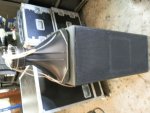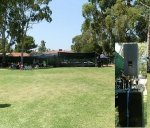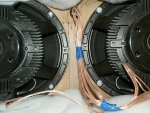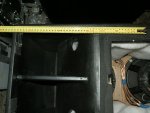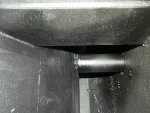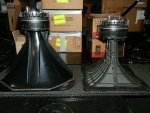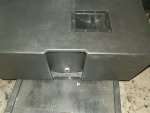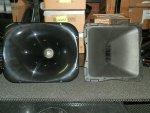Re: New DIY Mid High
Wow …. I think we almost need to split this thread in half and have section dedicated to compression driver design.
---------------------------------------------
Art, you need to do the mathematics associated with the various designs, calculate Xmax, efficiencies, SPL etc.
In general, most compression drivers use similar clearances between the diaphragm and phase plug. If the clearance gets too large and the volume of air between diaphragm and phase plug gets too large there will be a secondary HF roll off in addition to the mass break-point.
The clearance determines how low and how much power it can take before the diaphragm hits the phase plug. As the frequency increases the diaphragms displacement reduces proportionally.
All things being equal - if you reduce the size of the diaphragm it just has move further to produce the same SPL. If we are talking about very high frequencies there is plenty of room to do this. The diaphragm does not have to be as large and will not hit the phase plug.
The trick is getting it to do this efficiently. You can reduce the diaphragm mass, raise the resonant frequency and increase the compression ratio. As you make the diaphragm smaller the voice coil sized is normally reduced and hence the power handling, but if the efficiency increase is more than the power handling loss, then you’re ahead. As the diaphragm becomes smaller it also becomes much stiffer and can be made thinner and lighter.
The trick with the BMS design is that they have been able to reduce the mass but maintain a reasonable VC size. JBL have now picked up on this with their new D2430K that you mentioned. It functions very much like a driver patented by Mr BMS (can’t remember his name). Their design is like the BMS 4599 that uses 2 diaphragms to cover the same frequency range.
I looked at the D2430 but it didn’t go low enough and the 4599 didn't high enough to be used with the 2 x 12” bent horn, hence the 4594 ... and it sounds wonderful.
Anyway … as I mentioned in an earlier thread; this approach using a small + large diaphragm avoids break up modes and reduces intermodulation distortion and the output is the sum of both drivers .
As you like EV compression drivers this is what they did with DH3A. It was “optimized for use as a super-tweeter component in professional sound reinforcement systems”. It used a 14:1 compression ratio as compared to the DH1A that used a 10:1 ratio (if my memory is correct). In the early EV MT4 manifold systems they used 4 x DH3As for the VHF and 4 x DH2As for the HF, Turbosound also used the DH3A in combination with a horn loaded 6.5” driver in their Flash and Flood light systems. There new Flashline and Flex also use this concept.
They did this to get better performance (in EV case I never liked the sound of the DH2A) …. and the logic for doing this is exactly the same as what BMS have done with the 4594, except BMS have combined them into one driver. Turbosound claim that on music this combination gives them a 6 dB advantage when compared to a large format compression driver.
You were also concerned about distortion - I won't go into detail but we tend not to hear 2nd harmonics that much because they are often masked, higher orders can be an issue as is IMD. The type and frequency of the distortion is important. This paper may be of interest - http://gedlee.com/downloads/Distortion_AES_I.pdf
Jack,
Hidden, and pretty small ;^). The ribbed portion of the diaphragm probably is only contributing 50% to Sd.
Xmax on virtually all HF compression drivers is about the same, the winner in output is the driver with more Sd (cone/diaphragm) area, even with HF there is no replacement for displacement.
Smaller moving mass is a good thing from a distortion standpoint, a 4" diaphragm is too big (IMO) for clean HF reproduction, but a 3" diaphragm is OK, at least to my old ears.
If you compare Sd of a 3" dome diaphragm (easy to figure at PI r/squared) to the Sd of the annular ring diaphragms you can see why JBL "doubled up" on their D2, rather than use two diaphragms covering different frequency ranges.
Art
Wow …. I think we almost need to split this thread in half and have section dedicated to compression driver design.
---------------------------------------------
Art, you need to do the mathematics associated with the various designs, calculate Xmax, efficiencies, SPL etc.
In general, most compression drivers use similar clearances between the diaphragm and phase plug. If the clearance gets too large and the volume of air between diaphragm and phase plug gets too large there will be a secondary HF roll off in addition to the mass break-point.
The clearance determines how low and how much power it can take before the diaphragm hits the phase plug. As the frequency increases the diaphragms displacement reduces proportionally.
All things being equal - if you reduce the size of the diaphragm it just has move further to produce the same SPL. If we are talking about very high frequencies there is plenty of room to do this. The diaphragm does not have to be as large and will not hit the phase plug.
The trick is getting it to do this efficiently. You can reduce the diaphragm mass, raise the resonant frequency and increase the compression ratio. As you make the diaphragm smaller the voice coil sized is normally reduced and hence the power handling, but if the efficiency increase is more than the power handling loss, then you’re ahead. As the diaphragm becomes smaller it also becomes much stiffer and can be made thinner and lighter.
The trick with the BMS design is that they have been able to reduce the mass but maintain a reasonable VC size. JBL have now picked up on this with their new D2430K that you mentioned. It functions very much like a driver patented by Mr BMS (can’t remember his name). Their design is like the BMS 4599 that uses 2 diaphragms to cover the same frequency range.
I looked at the D2430 but it didn’t go low enough and the 4599 didn't high enough to be used with the 2 x 12” bent horn, hence the 4594 ... and it sounds wonderful.
Anyway … as I mentioned in an earlier thread; this approach using a small + large diaphragm avoids break up modes and reduces intermodulation distortion and the output is the sum of both drivers .
As you like EV compression drivers this is what they did with DH3A. It was “optimized for use as a super-tweeter component in professional sound reinforcement systems”. It used a 14:1 compression ratio as compared to the DH1A that used a 10:1 ratio (if my memory is correct). In the early EV MT4 manifold systems they used 4 x DH3As for the VHF and 4 x DH2As for the HF, Turbosound also used the DH3A in combination with a horn loaded 6.5” driver in their Flash and Flood light systems. There new Flashline and Flex also use this concept.
They did this to get better performance (in EV case I never liked the sound of the DH2A) …. and the logic for doing this is exactly the same as what BMS have done with the 4594, except BMS have combined them into one driver. Turbosound claim that on music this combination gives them a 6 dB advantage when compared to a large format compression driver.
You were also concerned about distortion - I won't go into detail but we tend not to hear 2nd harmonics that much because they are often masked, higher orders can be an issue as is IMD. The type and frequency of the distortion is important. This paper may be of interest - http://gedlee.com/downloads/Distortion_AES_I.pdf
Last edited:

